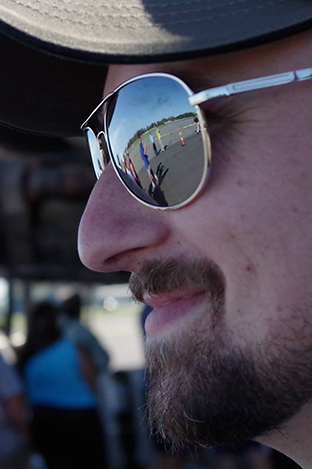Teaching Children to Fish
Taking a kid fishing is great family fun and a rite of passage for many. Avid anglers may feel eager to experience this family milestone early, and families that have little to no experience fishing may be wondering where to start.
Let me walk you through some of the time-tested methods for introducing a kid to fishing, regardless of age. By following these directions, the experience won’t result in horrible memories that will send them to a therapist later in life. Let’s go have some fun!
Kids of all ages can go fishing, as long as you match the trip to their age. By age six, kids are ready for the “full experience,” which means casting by themselves and maybe even taking a fish off the hook for the first time. But what about those avid anglers who want to get their kids fishing right away? Here are some ideas on getting these future anglers in on the action and starting to build some memories from a very young age.
Ages One to Five
14 months to 24 months: This is a fun time as a parent since your child is just starting to walk. He is curious about the world and craves stimulation. This is a great time to take him on a short hike in the woods along a small creek while he rides high on your shoulders in a baby carrier. Bring along a small rod that’s easy to carry, but forget the tackle box – just go with what’s on your line. Attention spans for this age group range from two to six minutes, according to experts.1 Plan on a few casts in spots you think might hold fish, and then move on to the next. Be sure to point out any wildlife or colorful fauna you see along the way. Don’t plan on spending more than 30 minutes on the whole trip, and gauge whether you should stay longer than that by your child’s reaction when you’re there. Oh, and don’t forget to bring a camera!
24 months to 36 months: As a parent, it seems like each week brings a new milestone for your child. She is using words, pointing to things by name, and is full of energy. Experts say that the average attention span for this age group ranges from five to eight minutes, so you can spend a little more time focusing on catching a fish on your outing. Just as before, make sure to plan a short trip that doesn’t focus solely on fishing. Either do the same trip as described above or head to a local small pond that has geese or waterfowl around it (just don’t feed them). Bring along an ultra-light rod and small lures. Try to catch a panfish along the shoreline while you walk around, and let your child help reel it in. Keep the camera ready so you can capture her reaction when she first sees the fish!
Three to five years: Children at this age are growing fast and might even seem like young adults at times. They are able to form solid memories that may last a lifetime. You can start planning excursions that are a little longer now, but still maintain a healthy mix of fishing and outdoor exploration. If they are good listeners, try taking them out in a boat that you feel safe operating with them in it. Just make sure that they wear a properly fitted United States Coast Guard approved life vest. Safety should always come first. Try paddling around in the shallow areas of a lake while trolling a small fly or lure behind the boat while your child holds the rod. If the lake has a panfish population, the odds are good your child will hook one. If the fish aren’t biting, though, it’s a fun experience for kids to see the different areas of a lake and go for a ride in a boat.
If you would rather stay on shore, you’ll still have luck. It’s common for some anglers to think that the best fish are far from the shore and require a boat or long casts to get at. However, most panfish are found close to the shoreline and are easy pickings. Feel free to let your child toss rocks in the water as you go. This will ruin all chances of catching a fish, but kids this young can’t resist the urge. At this age, the goal is just to introduce kids to the outdoors while you bring a fishing pole along for fun.
Ages Six and Up
All kids are old enough to go fishing, but by age six, they are old enough to be anglers. They finally have the dexterity and muscles needed to cast a rod on their own, along with the other skills you’re dying to show them.
Good-quality gear for your junior angler is easy to find and affordable. The last thing you want is for them to have equipment problems on this first real trip, as it just might sour them on fishing completely.
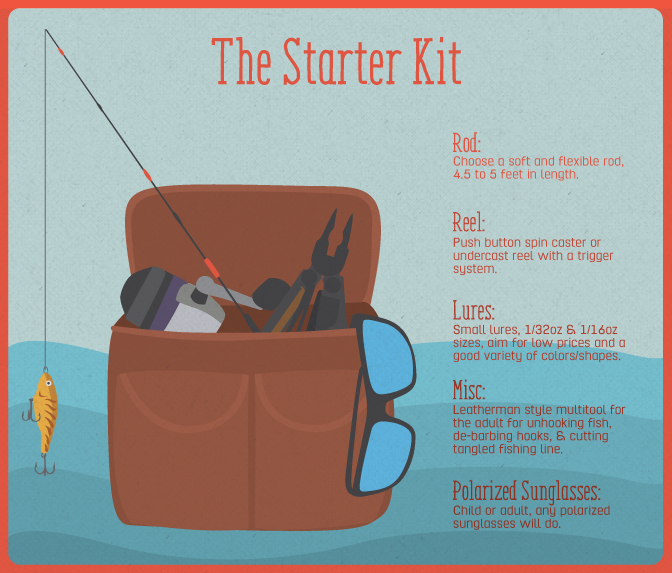
Stay away from the kids’ packages that have their favorite superhero or princess on them. These are basically disposable fishing setups that you will never use again and can cause you grief. Most of these packages come with stiff rods that are around 2’6” long and a plastic push-button spincasting reel. The short, stiff rods make casting a bit harder because of kids’ weaker casts, and the reels are notorious for jamming and birdnesting. Even if the rod package comes with a small set of lures and a case to keep them in, you’re not saving that much. These packages are in the $15-$30 price range at most retailers, and for a few bucks more, you can get something more reliable that is just as easy to use and that you can use should your children decide that fishing isn’t for them.
Here’s the better option: get an ultra-light rod and reel. Ultra-light poles and reels are popular amongst anglers who target smaller game fish, and they are perfect for kids age six and up. Fishing gear has become so mass-marketed over the past few decades that it’s easy to pick up a good ultra-light rod/reel combo in the $20-$30 price range. Look for one with a rod length between five and six feet, find the most flexible one you can, and make sure that the reel looks as simple to use as possible.
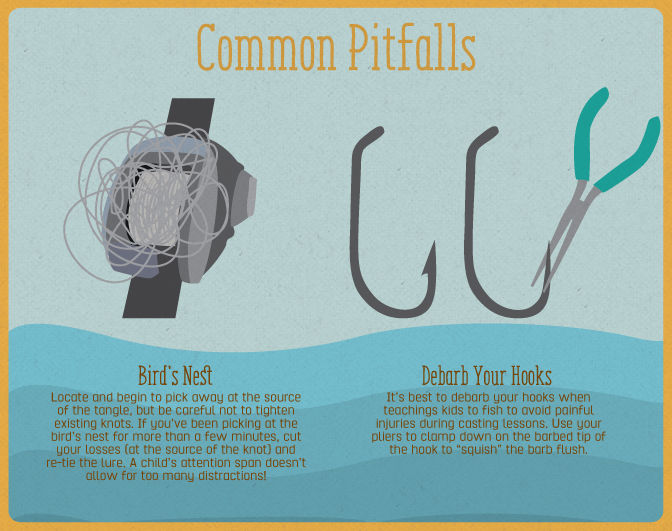
Lures
For your child’s first trip out, don’t plan on targeting hard-to-catch fish like bass, walleye, trout, or salmon. They will have just as much fun catching a small fish as you would a trophy marlin. Get small lures designed to target panfish. Don’t spend a ton of money on lures; panfish will strike at garbage if you toss it in the water. The common panfish lure sizes are 1/32 oz. and 1/16 oz. Feel free to ask the store clerk for help if you need it. Plan on losing five or more lures to weeds, trees, and other environmental elements.
What you need: Various 1/32 oz. and 1/16 oz. panfish lures.
How to fish it: Cast into shallow areas and along the side of weed beds. Change the reeling speed with each cast to trigger a bite. Move to a different area if unsuccessful after five to 10 casts.
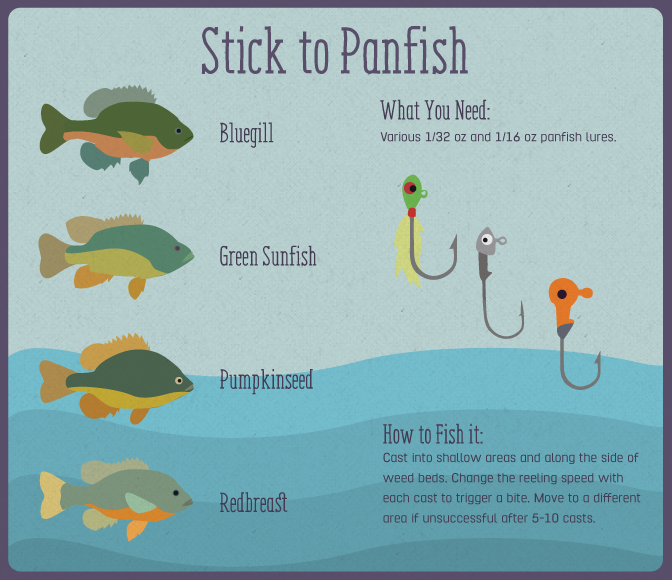
Live Bait
Using live bait requires using a barbed hook. Barbed hooks can be very dangerous, painful, and difficult to remove should someone get hooked. Bait hooks are designed with extra barbs to keep live bait on the hook. Using small lures with debarbed hooks is a much safer method for kids.
Should you choose to expose kids to the “oh, gross!” factor of putting a worm on a hook, make sure that you buy the worms that day and check them at the store. If you plan on buying them the day before, you can store them in your home fridge for the night (they won’t escape, and the cold puts them into natural hibernation).
What you need: Size 6 or 8 snelled bait hooks (snelled hooks come with small pieces of fishing line pre-tied to the hook), and small floats (aka bobbers) less than one-inch in diameter or an assorted pack.
How to fish it: Set the bobber on the line a few inches up from the hook. You can start by using the length of your fist. Let it sit for 60 seconds. Reel it in, check to see that the bait is still there, and cast back in a different spot. Do this three or four times and then try another nearby fishing spot.
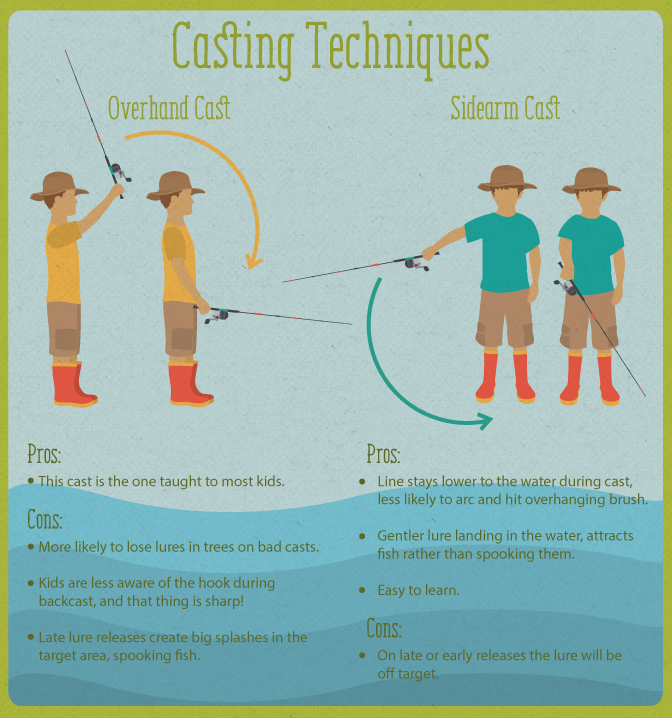
Before You Hit the Water
Children’s first fishing trip should be fun and memorable. But let’s be honest – they want to catch a fish, and you want that picture of them for the scrapbook. While there are no guarantees in fishing, there are a few fun and easy steps you can take to increase their success rate. Teaching them how to cast for themselves is one of the most practical and fun ways to get the ball rolling.
The Casting Game
What you need:
- 1 hula hoop (or more!)
- 1 bobber
- Tape measure
The first time that most kids cast a fishing pole is when they are on the water. The child is inevitably going to have sloppy casts that scare the fish, lose many lures in the trees, or feel intimidated and hand the rod to you. This simple activity can help alleviate that stress and can also turn into a fun family game!
Mark an area of the lawn that they have to cast from, and think of it as home plate. From that spot, lay out three hula hoops, all in a straight line. The hoops should be, respectively, 12 feet, 20 feet, and 30-35 feet away from home plate.
Have them practice using a side-arm cast. Aim for the hoops, and see how close they get! If you only have one hula hoop, place it around 20 feet away and move it in or out depending on their progress. The goal here is just to get them feeling comfortable with casting and build their confidence with the equipment.
Fishing requires patience, which is something most kids aren’t born with. By using these short fun activities, it will help peak their interest in fishing, and help develop a sense of patience in the future. Most importantly, don’t forget you’re building memories to last a lifetime (yours and theirs)!
Text and graphics provided by Fix and used with permission. Child fishing image courtesy Albuquerque BioPark (CC-BY-NC-ND 2.0).


